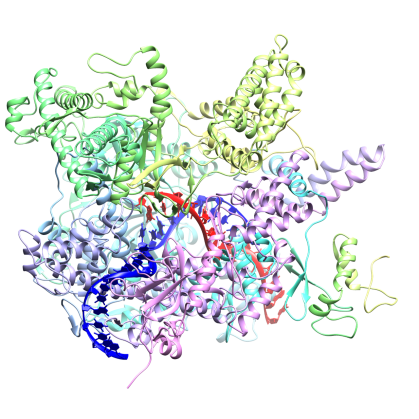Gut Microbiome Manipulation Could Result from Virus Discovery
Rutgers co-authored research could aid efforts to engineer beneficial bacteria

Scientists have discovered how a common virus in the human gut infects and takes over bacterial cells – a finding that could be used to control the composition of the gut microbiome, which is important for human health.
The Rutgers co-authored research, which could aid efforts to engineer beneficial bacteria that produce medicines and fuels and clean up pollutants, is published in the journal Nature.
“CrAssphages are the most abundant viruses infecting bacteria in the human gut. As such, they likely control our intestinal community of microbes (the microbiome),” said co-author Konstantin Severinov, a principal investigator at the Waksman Institute of Microbiology and a professor of molecular biology and biochemistry in the School of Arts and Sciences at Rutgers University–New Brunswick. “Understanding how these tiny viruses infect bacteria may allow scientists to control and manipulate the makeup of the microbiome, either by increasing the proportion of beneficial bacteria in our intestines or decreasing the number of harmful bacteria, thus promoting health and fighting disease.”
Scientists found that crAssphages use their own enzyme (an RNA polymerase) to make RNA copies of their genes. RNA has the genetic information to make proteins. All cells, ranging from bacterial to human, use such enzymes to make RNA copies of their genes. And these enzymes are very similar in all living matter, implying that they’re ancient and related by common ancestry, Severinov said.
When the team revealed the atomic structure of a crAssphage enzyme, they were surprised to learn that it is distinct from other RNA polymerases but closely resembles an enzyme in humans and other higher organisms that is involved in RNA interference. Such interference silences the function of some genes and may lead to certain diseases.
“This is a startling result. It suggests that enzymes of RNA interference, a process that was thought to occur only in cells of higher organisms, were ‘borrowed’ from an ancestral bacterial virus early in evolution,” Severinov said. “The result provides a glimpse of how cells of higher organisms evolved by mixing and matching components of simpler cells and even their viruses.”
“In addition to deep evolutionary insights, phage (viral) enzymes such as crAssphage RNA polymerase may be used in synthetic biology to generate genetic circuits that do not exist in nature,” he said.
Synthetic biology involves redesigning organisms so they can, for example, produce a medicine, nutrient or fuel, sense something in the environment or clean up pollutants, according to the National Human Genome Research Institute.
“We are now trying to match the thousands of different crAssphage viruses in our gut with the bacterial hosts they infect,” Severinov said. “By using just the ‘right’ bacterial virus, we will be able to get rid of bacteria it infects, which will allow us to alter the composition of the gut microbiome in a targeted way.”
Leonid Minakhin at the Waksman Institute of Microbiology contributed to the study along with scientists at many other institutions.

